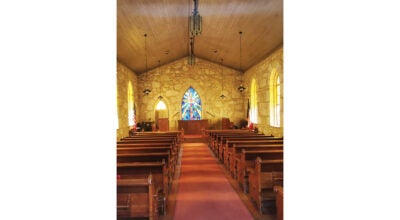Thanksgiving Royalty
Published 6:32 pm Wednesday, November 24, 2010
Fenced in by 100 feet of green poultry netting, Chief the turkeyleads a life of “can’t.”
He’s pestered all day by a mess of chickens, but he can’t runthem off. He can call half a dozen hens up from the woods with histhroaty gobbling every morning, but he can’t get out to love onthem. He never goes hungry on a plentiful diet of corn feed, but hecan’t change what’s on the menu.
But there’s one “can’t” working in the Chief’s favor. He can’tend up in the oven for Thanksgiving.
“He’s our pet. He’s not for the dinner table,” said MaxineKudra. “We saved him from being somebody else’s dinner.”
For Chief, a black and white 3-year-old Royal Palm turkey wholives a peaceful life and sleeps on a straw bed in the Lake Lincolnarea, Thanksgiving is just another day.
He’s a rescue bird.
Maxine’s sister, Wendy Mast of Pembroke, Ky., takes in abusedand neglected animals and adopts the pets of military servicemenwho have no choice but to give them up when they deploy. Mastrescued Chief from a particularly harsh home in the Bluegrass Stateone year ago and passed him on to the Kudras, who take in abandonedchickens and other fowl.
“Most people tend to go for the dogs and cats. People don’t havemuch time for fowl,” Maxine said. “It’s hard to find homes forthem.”
Chief is lucky to have the Kudras. The big turkey was almost adead duck.
“He was in real bad shape when we got him,” Maxine said. “He wasin an abusive place. They wouldn’t feed him. All his tail feathershad fallen out. We nursed him back to health on antibiotics andspecial care.”
The loss of Chief would have been a loss to his breed. Therearen’t many of them out there.
According to Slow Food USA, Royal Palm turkeys were first bredin Lake Worth, Fla., in the 1920s. The breed is smaller than mostturkeys, weighing in at 10-16 pounds. Their small size makes themunsuitable for commercial meat production, and most are kept onfarms or raised as show birds.
The American Livestock Breeds Conservancy lists the Royal Palm a”threatened” breed, with fewer than 1,000 breeding birds in theU.S. and fewer than seven breeding flocks.
But Chief is the picture of health, and now he rules the roost,which he shares with 32 chickens, bantams and dominickers.
Named so because his wide fan of white and black-stripedfeathers resembles an Indian headdress, he puffs out his chest andstruts along on his owners’ heels with the loyalty of a puppy. Hestomps around in the “turkey dance” when he gets excited.
When Maxine whistles or calls him “Chiefy-man,” he gobbles everytime.
“He’s the star of the show,” she said. “The supervisor of thechicken coop.”
Chief gives thanks for his cushy life by giving back to hisowners. Just watching the big bird and all his chickens strut andprance around is calming, James said.
“They’re stress relievers,” he said. “I enjoy just watchingthem. It’s like going fishing – you don’t catch any fish, but youstill relax. You come out here and talk to them, you don’t get nobacktalk.”
James’ father kept domestic turkeys when he was a child, andhe’s never had the urge to harm one.
“I don’t even hunt them. I just get up in the stand and look atthem. They’re too pretty to shoot,” he said.
The Kudras sure wouldn’t harm Chief. In fact, they may bring acompanion home to Chief when they return from a plannedThanksgiving vacation to Kentucky.
“We don’t know what we’ll pick up,” Maxine said.
It could be a very good Thanksgiving for the love-starved Chief,but it will remain one of terror for other turkeys. Not even Chiefhas any sympathy for his cousins – as often is the case with fowl,he’ll consume his own kind.
“He eats turkey and dressing, too. He’s a cannibal,” Maxinesaid.





